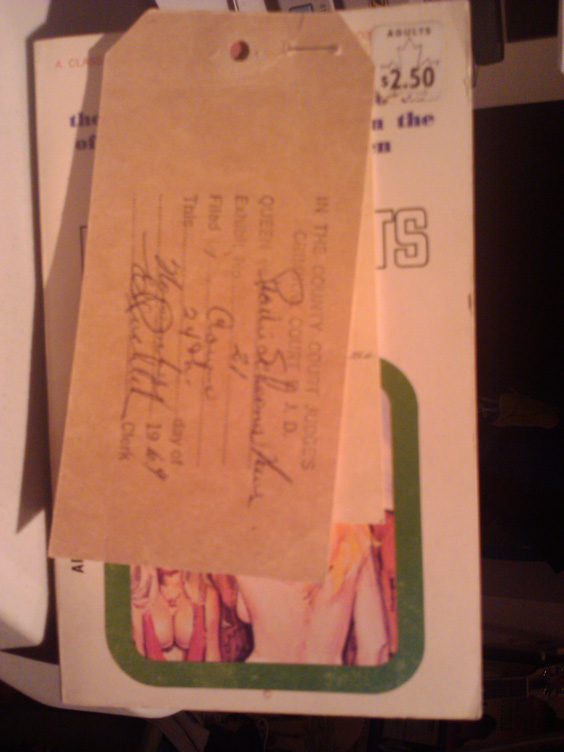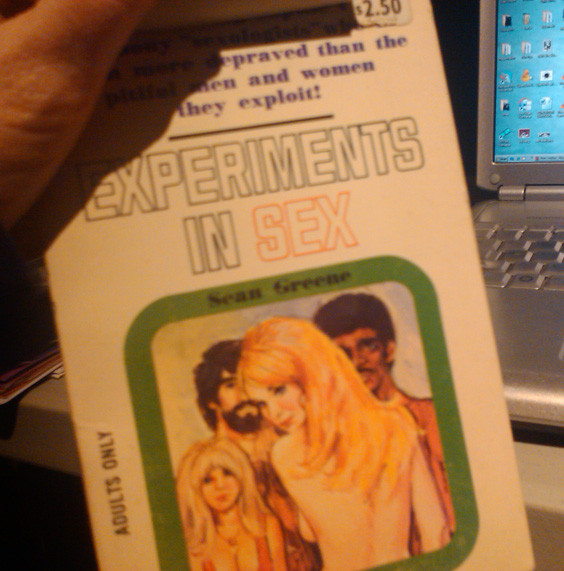HIP POCKET SLEAZE
HIP POCKET SLEAZE
John Harrison
Published by HeadPress, 2011
Review by Kier-La Janisse
———————–
I couldn’t wait to get my hands on John Harrison’s compendium of sleazy pulps, covering everything from triple-X sexcapades to occult propaganda to cheap B-movie tie-ins. When I first heard of it in the Headpress announcements (Headpress being, like FAB, Feral House and Fantagraphics, one of those publishing houses you really want to be on a mailing list for), I didn’t realize the breadth of its subject matter, thinking it specifically covered porn literature from the 40s through the 70s, a genre that – thanks to my dad – I have come to appreciate and collect over the viagra to order years. Let me explain: A few years before I was born, when pornography was still illegal in this country, cheap cialis in usa a little convenience store in Winnipeg called Prairie Schooner News was raided and charged with selling illicit pornographic material. Hundreds of pocketbooks, snapshots, slides,homemade magazines, bawdy playing cards and dirty comics were all brought before the court as evidence. Every paperback had an evidence tag stapled to the http://www.spectacularoptical.ca/2021/03/canada-cialis/ cover (thereby forever ruining its value as a collectible). But with the sexual revolution in full force and times-a-changin’ fast, they weren’t quite ready to throw the book at the independent store owner. Instead, they sought an expert opinion to determine whether the material had any historical, sociological, scientific or artistic merit. The expert in question? My dad.
Dad lugged home nearly 20 boxes of porn, and I can only guess at what happened next. All I know is that when I was a kid, these boxes had been languishing in the cubby hole in the basement for some canada cialis no prescription years. And as soon as I was old enough to
read I hung out in the cubby hole amidst all these dusty paperbacks, safely nestled in the little fort I had made out of a TV box, voraciously absorbing book after book in between looking up words like ‘dildo’ in the dictionary (it wasn’t there, not in those days). I didn’t even know what a penis looked like but I was happy to read about all the crazy things it could do. Over a decade later, when my father was moving, he graciously donated all this material cialis online doctor to me. The more offensive material that I was afraid to have in my house I donated in turn to Robin Bougie of Cinema Sewer, some I gave away as Christmas presents or prizes at my first horror film festival, and the rest I still have to this day.
So now, back to John Harrison’s book. Hopefully my ‘personal interest angle’ worked and you are now all dying to read about what perverse pleasures lie between the pages of this weird and wonderful tome. Harrison clearly felt the same way, because he begins the book with a personal story about his trips to the secondhand bookshop that lay at the gateway of a crumbling amusement park, on a street filled with neon signs, dive bars and greasy food joints, and the ‘adults only’ section that was cordoned off in the back, beckoning his young curious mind. It was this verboten room that fuelled his interest in the subject matter that would turn into Hip Pocket Sleaze.
The book is divided into several sections, all of which do not necessarily flow into one another, and are broken up further by checklists comprising the select catalogues of certain writers, publishing houses and cover artists (some of which will be repeated throughout the book as appropriate and as one huge list at the end). But the seemingly ramshackle structure mirrors in a sense the layers and clutter of those bookshops that would sell this stuff; instead of tidy alphabetization or numerical coding, the book is like a trip into a messy subconscious, with all its tangents and threads hungrily veering off in order to get deeper into the heart of the subject matter. That said, the book does start at an appropriate point: the birth of the paperback in the 1800s and its proliferation as a mode of off-duty entertainment for soldiers during WWII, the era most commonly associated with “pulp fiction”. From there, he jumps straight into the advent of the adult paperback business in the late 19th century, which really took hold in the late 50s and further in the 60s as censorship guidelines for print material started to loosen up in some places. Of course, the books were still largely suggestive, even though they bore lurid titles like Naked on Roller Skates and The Love Toy, but by the late 60s there was illustrated or photographed nudity on the book covers and graphic descriptive sex of all types – usually without common foul language, which is part of what makes the writing so enduringly entertaining.
Harrison talks about the impressive number of science fiction and mystery writers who had crossover careers in adult fiction under a variety of pseudonyms – including Marion Zimmer Bradley, Lawrence Block and Harlan Ellison – and features Interviews and profiles of well known adult fiction writers such as Ann Bannon (author of the groundbreaking Beebo Brinker lesbian pulp series), Richard E. Geis (who was not afraid of the more taboo subjects like bestiality and incest), Jim Harmon (whose agent, Forrest J. Ackerman turned him onto the erotica market, and who starred in Ray Dennis Steckler’s Lemon Grove Kids Meet the Monsters), Ron Haydock (teenage rockabilly musician, sometime writing partner of Jim Harmon, also a Steckler regular and onetime columnist for Famous Monsters), and Ed Wood, Jr., who needs no introduction. While all the interviews are full of great insights and anecdotes, the icing is a hilarious, rambling letter from Robert Tralins (aka ‘Explorer of the Unknown’) who did not wish to be interviewed because he was offended by the book’s title. Following this is a chapter is devoted to the fantastic illustrated cover art of Gene Bilbrew (one of few African-American’s working in the field), Bill Ward (a comic artist and regular illustrator for Cracked Magazine), and Eric Stanton (the latter also the subject of a Taschen art book), three of the most recognizable talents of the adult paperback biz.
After a 20-page roundup of vintage paperback reviews, the book plunges into its meatiest chapter, on the sleazier specialty subgenres of the 70s, which is an overload of developmental history, reviews, interviews and publisher profiles spanning everything from incest tales (Hot Incest Family) to roughies (Mom’s Rape Cure), bestiality (Bestial Nymph), race sex (Black Ghetto Teen), Nazi exploitation (Women of Auschwitz) and movie tie-ins for Deep Throat and Doris Wishman’s Let Me Die a Woman. The book starts to go off the rails a bit when it gets into New English Library – perhaps best known for the Richard Allen Skinhead series and its youth subculture spin-offs – who specialized in all manner of exploitation lit from biker books to spy cheapies, giant monster extravaganzas and occult oddities. From there we go into a chapter called ‘other genres’, where we encounter more witchcraft, drugsploitation, Manson-mania and horror movie making-ofs and novelizations (including Herschell Gordon Lewis’ self-penned novelizations for Blood Feast, Two Thousand Maniacs and Color Me Blood Red). Don’t get me wrong, I’m a fan of this brand of trash (especially the NEL stuff) and loved reading about them, but some of these latter books were marketed at teenagers and pre-teens, making them hardly ‘adult’ material in line with the content of the book’s first half (Actually, I’d love to see a book just about New English Library). While there are structural hiccups in the first half, by this point it seems like a pop-cultural free-for-all. Luckily Harrison’s probable audience is increasingly diverse in its tastes and this won’t be a sticking point for many, especially considering how inherently entertaining all of this subject matter is.
Ultimately though, both the book’s structure and its content reinforce the point that rules were made to be broken, and boundaries meant to be tested and transgressed. For pop culture fans, this is what keeps us going – the belief that knowledge has no end, that everything leads to something else to enthral and invigorate us. And the promise of a good dose of low-class literature to warm up to at the end of the day.

 February 1, 2012
February 1, 2012  No Comments
No Comments





